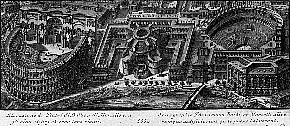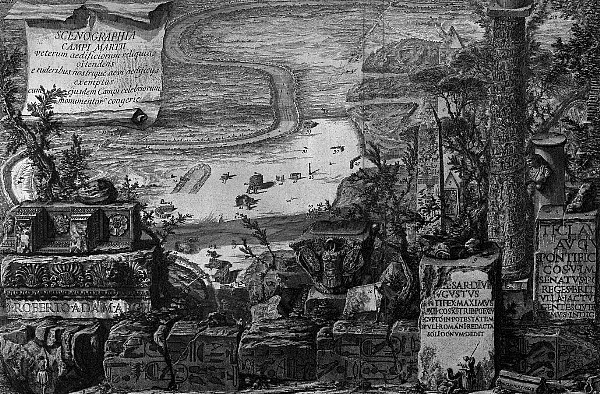sex, Mars, reenactment
1997.11.20
...the phrase, "back to daddy's balls, architecture halls"... ...a connection between this line and the Ichnographia. ...Mars being the father of Romulus--the founder of Rome, and the connection of sex and conception within plans... ... the "testicles" of the Templum Martis as generators...
...the prominence of Mars... ...Piranesi actively redesigned Imperial Rome as he came to understand it. Piranesi assimilated all the knowledge about this part of the city, and through that assimilation he delineated an optimal synthesis. Piranesi's plan of the Campo Marzio is not an architectural reconstruction, but an archeological redesign. Piranesi's plan is not a rendition of what was, rather a rendition of what could have been. Piranesi's plan is not a reconstruction, but an historical reenactment.
The Ichnographia is a powerful reenactment of the architectural history of the Campo Marzio. The history, moreover, is not limited to Imperial Rome. Although the buildings are named for those primarily of the late Empire, Piranesi also very cleverly and extremely subtlely reenacts the architectural history of the Campo Marzio beyond the Imperial Age, specifically the inversion/conversion of Rome from pagan state to Christian state.
The opening stage for the reenactment is the Scenographia (whose very title has obvious theatrical connotations)...
...regarding the Ichnographia as a stone fragment: a reenactment of the Forma Urbis--a virtual reenactment of discovering the great missing piece of the "puzzle" that will bring all the other piece to a grand cohesion. (...here reminded of Tafuri's opening comments to The Sphere and the Labyrinth: "There comes a moment (though not always) in research when all the pieces begin to fall into place, as in a jig-saw puzzle, where all the pieces are near at hand and only one figure can be assembled (and thus the correctness of each move be determined immediately)..."
| |
Mistakes and Inversions
1998.02.19
...address Piranesi's own mistakes and inversions, particularly the inversion of the Circus Flaminius (which I now know to be also exchanged in location with the theater of Balba, which further shows Piranesi's intentional "mistakes" to make a specific point). [Perhaps,] Piranesi makes the mistakes, first to call attention to specific points, and second to highlight the notion of inversion. Piranesi is indeed being theatrical, which is only natural because of the whole notion of reenactment. ...discuss the Ichnographia's Triumphal Way and how Piranesi redesigns (reenacts) the Way making it more ideal to its purpose (marching through the theater district). The Way (within Ichnographia at least) ends at the Temple of Janus--a perfect example of inversion. Then following the Triumphal Way in reverse manifests the Christian theme of salvation and redemption, ending at the inverted "basilica"--the upside-down "inverted" crucifixion of St. Peter. ...the Ichnographia not only represents the history of ancient pagan city of Rome, but also the Christian city of Rome. This evokes Augustine's The City of God and also Bloomer's notion of the Ichnographia transcending time.
...the Scenographia as the stage upon which Piranesi reenacts--this is the first scene and the "play" is about to begin. In the course of the "play" the most egregious "mistake/inversion" is the misplacement and disorientation of the Circus Flaminius and its actual exchange with the Theater of Balba. This "mistake" manifests a composition of inverted theaters--essentially a double inverted theater. This configuration becomes one of the Il Campo Marzio's final scenes and thus represents the double inverted "theater" of Rome's own history--the narrative of pagan Rome and the narrative of Christian Rome, and in the Ichnographia the one story is indeed a reflection of the other.

| |
homo ludens and the Ichnographia
1999.07.14
There are certain passages within Homo Ludens that relate to Piranesi's "play" of the Ichnographia Campus Martius, especially with regard to reenactment, the Scenographia, and the double theater. There are also connections between ritual and play that relate to the Triumphal Way.
Piranesi's Continual Double Theaters
2001.11.26
|



